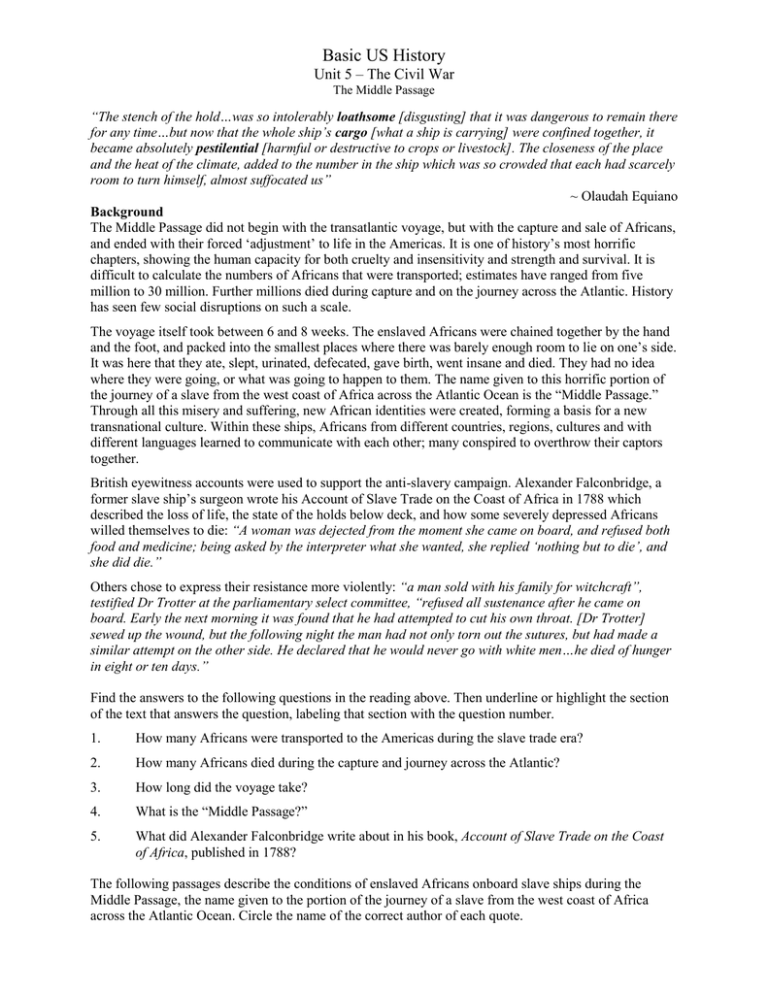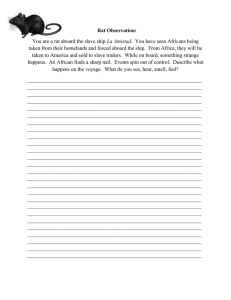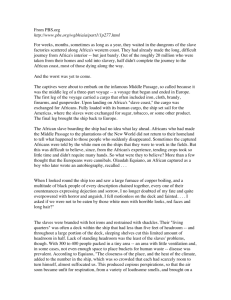Basic US History Unit 5 – The Civil War
advertisement

Basic US History Unit 5 – The Civil War The Middle Passage “The stench of the hold…was so intolerably loathsome [disgusting] that it was dangerous to remain there for any time…but now that the whole ship’s cargo [what a ship is carrying] were confined together, it became absolutely pestilential [harmful or destructive to crops or livestock]. The closeness of the place and the heat of the climate, added to the number in the ship which was so crowded that each had scarcely room to turn himself, almost suffocated us” ~ Olaudah Equiano Background The Middle Passage did not begin with the transatlantic voyage, but with the capture and sale of Africans, and ended with their forced ‘adjustment’ to life in the Americas. It is one of history’s most horrific chapters, showing the human capacity for both cruelty and insensitivity and strength and survival. It is difficult to calculate the numbers of Africans that were transported; estimates have ranged from five million to 30 million. Further millions died during capture and on the journey across the Atlantic. History has seen few social disruptions on such a scale. The voyage itself took between 6 and 8 weeks. The enslaved Africans were chained together by the hand and the foot, and packed into the smallest places where there was barely enough room to lie on one’s side. It was here that they ate, slept, urinated, defecated, gave birth, went insane and died. They had no idea where they were going, or what was going to happen to them. The name given to this horrific portion of the journey of a slave from the west coast of Africa across the Atlantic Ocean is the “Middle Passage.” Through all this misery and suffering, new African identities were created, forming a basis for a new transnational culture. Within these ships, Africans from different countries, regions, cultures and with different languages learned to communicate with each other; many conspired to overthrow their captors together. British eyewitness accounts were used to support the anti-slavery campaign. Alexander Falconbridge, a former slave ship’s surgeon wrote his Account of Slave Trade on the Coast of Africa in 1788 which described the loss of life, the state of the holds below deck, and how some severely depressed Africans willed themselves to die: “A woman was dejected from the moment she came on board, and refused both food and medicine; being asked by the interpreter what she wanted, she replied ‘nothing but to die’, and she did die.” Others chose to express their resistance more violently: “a man sold with his family for witchcraft”, testified Dr Trotter at the parliamentary select committee, “refused all sustenance after he came on board. Early the next morning it was found that he had attempted to cut his own throat. [Dr Trotter] sewed up the wound, but the following night the man had not only torn out the sutures, but had made a similar attempt on the other side. He declared that he would never go with white men…he died of hunger in eight or ten days.” Find the answers to the following questions in the reading above. Then underline or highlight the section of the text that answers the question, labeling that section with the question number. 1. How many Africans were transported to the Americas during the slave trade era? 2. How many Africans died during the capture and journey across the Atlantic? 3. How long did the voyage take? 4. What is the “Middle Passage?” 5. What did Alexander Falconbridge write about in his book, Account of Slave Trade on the Coast of Africa, published in 1788? The following passages describe the conditions of enslaved Africans onboard slave ships during the Middle Passage, the name given to the portion of the journey of a slave from the west coast of Africa across the Atlantic Ocean. Circle the name of the correct author of each quote. 1. “The treatment of the seamen was cruel from the very beginning to the end of the voyage. Ropes and handspikes were in common use; and were often kicked and beaten with the fist for only imaginary faults…there was not one [voyage] in which a seaman was well used.” Ship captain 2. Former slave Abolitionist Doctor Sailor Former slave Abolitionist Doctor Sailor Former slave “The captain of an English ship had enticed several of the natives on board, and finding a favourable opportunity, sailed away with them. His vessel however was driven back to the coast from whence it had set sail, and was obliged to cast anchor on the very spot where this act of treachery had been committed. At this time two other English vessels were lying in the same river. The natives, ever since the transaction, were determined to retaliate…they accordingly boarded the three vessels, and having made themselves masters of them, they killed most of their crews.” Ship captain 6. Sailor “[Slaves] had sufficient room, sufficient air, and sufficient provisions. When upon deck, they made merry and amused themselves with dancing. As to mortality… it was trifling. In short, the voyage from Africa to the West Indies was one of the happiest periods of a Negro’s life.” Ship captain 5. Doctor “This wretched situation was again aggravated by the galling of the chains, now become insupportable; and the filth of the necessary tubs, into which the children often fell, and were almost suffocated. The shrieks of the women, and the groans of the dying, rendered the whole a scene of horror almost inconceivable.” Ship captain 4. Abolitionist Abolitionist Doctor Sailor Former slave Imagine you are one of the figures involved in the Atlantic Slave Trade (ship captain, abolitionist, doctor, sailor, or slave). In the space provided below, write a short note to a friend at home describing what you experience (see, hear, smell, touch, taste) during the Middle Passage. _____________________________________________________________________________________ _____________________________________________________________________________________ _____________________________________________________________________________________ _____________________________________________________________________________________ _____________________________________________________________________________________ _____________________________________________________________________________________ _____________________________________________________________________________________ _____________________________________________________________________________________ _____________________________________________________________________________________ _____________________________________________________________________________________ _____________________________________________________________________________________




